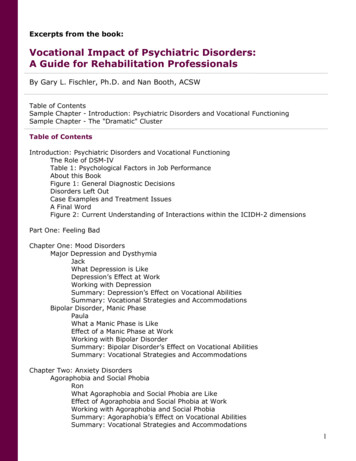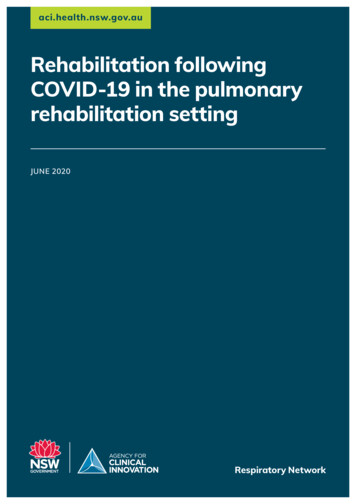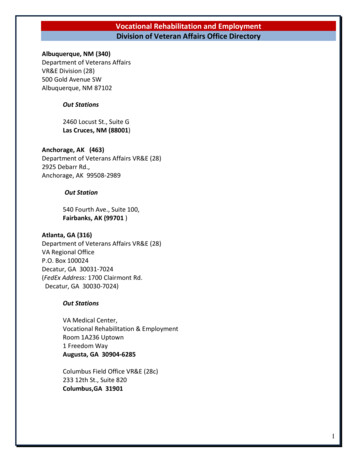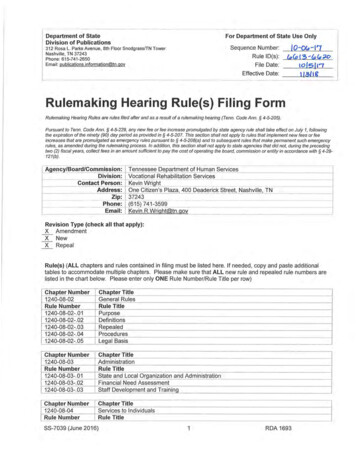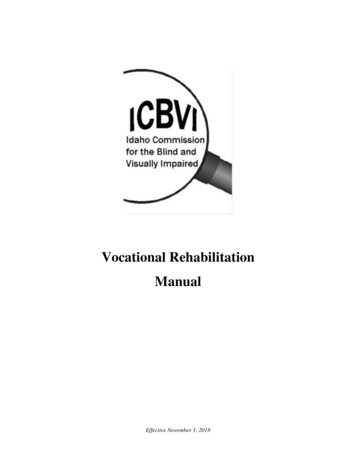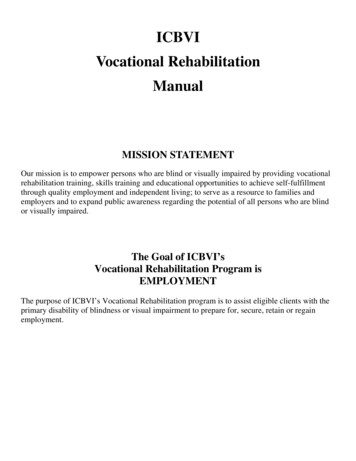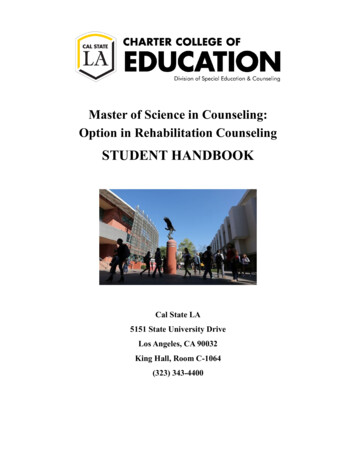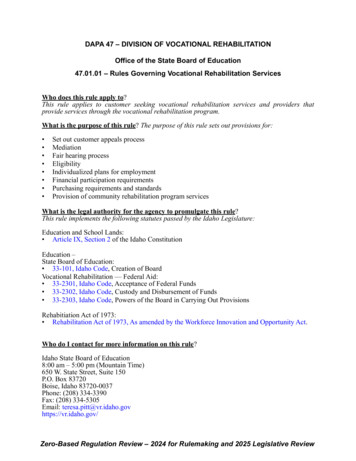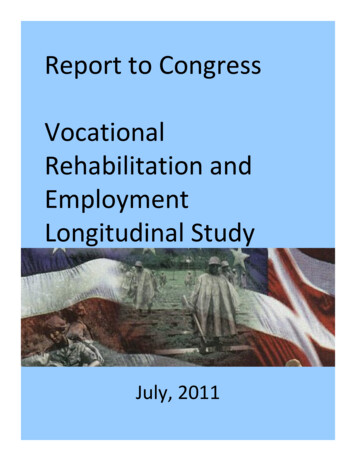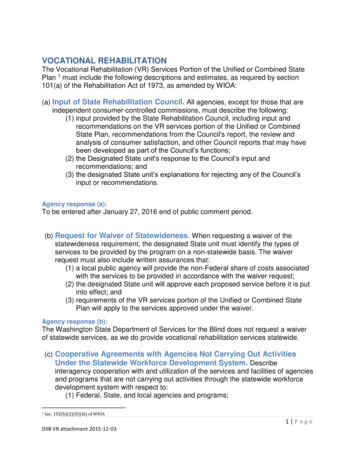
Transcription
VOCATIONAL REHABILITATIONThe Vocational Rehabilitation (VR) Services Portion of the Unified or Combined StatePlan 1 must include the following descriptions and estimates, as required by section101(a) of the Rehabilitation Act of 1973, as amended by WIOA:(a) Input of State Rehabilitation Council. All agencies, except for those that areindependent consumer-controlled commissions, must describe the following:(1) input provided by the State Rehabilitation Council, including input andrecommendations on the VR services portion of the Unified or CombinedState Plan, recommendations from the Council's report, the review andanalysis of consumer satisfaction, and other Council reports that may havebeen developed as part of the Council’s functions;(2) the Designated State unit's response to the Council’s input andrecommendations; and(3) the designated State unit’s explanations for rejecting any of the Council’sinput or recommendations.Agency response (a):To be entered after January 27, 2016 end of public comment period.(b) Request for Waiver of Statewideness. When requesting a waiver of thestatewideness requirement, the designated State unit must identify the types ofservices to be provided by the program on a non-statewide basis. The waiverrequest must also include written assurances that:(1) a local public agency will provide the non-Federal share of costs associatedwith the services to be provided in accordance with the waiver request;(2) the designated State unit will approve each proposed service before it is putinto effect; and(3) requirements of the VR services portion of the Unified or Combined StatePlan will apply to the services approved under the waiver.Agency response (b):The Washington State Department of Services for the Blind does not request a waiverof statewide services, as we do provide vocational rehabilitation services statewide .(c) Cooperative Agreements with Agencies Not Carrying Out ActivitiesUnder the Statewide Workforce Development System. Describeinteragency cooperation with and utilization of the services and facilities of agenciesand programs that are not carrying out activities through the statewide workforcedevelopment system with respect to:(1) Federal, State, and local agencies and programs;1Sec. 102(b)(2)(D)(iii) of WIOA1 PageDSB VR attachment 2015-12-03
(2) State programs carried out under section 4 of the Assistive Technology Actof 1998;(3) Programs carried out by the Under Secretary for Rural Development of theDepartment of Agriculture;(4) Noneducational agencies serving out-of-school youth; and(5) State use contracting programs.Agency response (c):The Washington State Department of Services for the Blind (DSB) believes thatcollaboration with stakeholders is essential to assisting people with disabilities tosuccessfully become employed. Such an ongoing effort maximizes resources andaddresses the quality of life issues that can enhance the ability of a person with adisability to obtain and maintain employment. We have active collaboration with thefollowing organizations and agencies (and formal memorandums of understanding(MOUs) where noted).The DSB engages in activities with the Washington State School for the Blind (WSSB),school districts, teachers of the visually impaired, and families of students with a visualdisability. If the student has a co-occurring disability, we advise co-enrollment with ourpartner agency the DSHS Division of Vocational Rehabilitation (DVR). DSB, DVR andthe Office of Superintendent of Instruction (OSPI) have a memorandum ofunderstanding of how all parties support transition youth services.The DSB engages with the Center for Change in Transition Services (CCTS). TheCCTS is a Washington State Needs Project funded annually by federal resources fromthe Office of the Superintendent of Public Instruction (OSPI). The goal of CCTS is toimprove post-school outcomes for students with disabilities in the state. CCTS hasprovided transition services training, resources and technical support to DSB staff insupport of the agency’s transition youth services.The DSB engages with the Blind Youth Consortium, a quarterly meeting of partneragencies (DSB; Washington State School for the Blind; Washington Sensory DisabilityServices; Lighthouse for the Blind; Washington Talking Book and Braille Library; OSPIEducational School Districts; the Department of Early Learning; the Department ofHealth; Seattle Children’s Hospital; University of Washington) to collaborate and shareresources on blind youth issues within Washington State. The group worked to refinecoordination of Birth – 3 vision services statewide, and have collaborated in the need toidentify and provide services for individuals with either ocular and/or cortical visualimpairment at the earliest point.The DSB engages actively with Public Institutions of Higher Education. DSB and DVRhave entered into a formal agreement with the Public Institutions of Higher Education inWashington. This agreement facilitates collaboration for our participants with disabilitieswho are attending Higher Education schools in Washington State. One of the primary2 PageDSB VR attachment 2015-12-03
components in the agreement concerns cost sharing for certain high costaccommodations.The DSB engages with the Washington Assistive Technology Act Program (WATAP) tobroaden access and services to adaptive technology for the agency participants. TheDSB and WATAP have an interagency agreement to facilitate equipment loans,technology assessment services and trainings. The DSB informs agency participants offunding mechanisms for adaptive technology through the Washington AccessTechnology Fund, and works with the Deaf Blind Equipment Program to coordinatetechnology assessment and training.The DSB engages in activities with tribal vocational rehabilitation programs, meetingquarterly in each region of the state with the eight partner tribal programs and the DVR,and all partners meet annually to refine the memorandum of understanding on how wewill partner on service delivery.The DSB engages with the Vocational Rehabilitation and Employment program throughthe Veteran’s Administration (VA), and the agency has entered into a memorandum ofunderstanding among the DVR and the VA on how all will partner to provide servicesamong potentially shared customer base.The DSB engages with the Washington Sensory Disability Services (WSDS). DSB staffpartner with the WSDS in providing referrals and services to children who are deaf orhard of hearing, blind or visually impaired, or deaf-blind, and provides training and othersupports to families and service providers. The WSDS is a strong partner within theBlind Youth Consortium.The DSB engages with the Office of the Deaf & Hard of Hearing (ODHH). ODHH is astate agency that provides resources for our Deaf Blind participants, includingtelecommunication-related services, reasonable accommodations to access DSHSservices and human services via regional service centers of the deaf and hard ofhearing. ODHH manages the funds for the Deaf Blind Service Center, which providesinformation, referral and Support Service Providers for environmental interpretation.The DSB engages with the Helen Keller National Center (HKNC). The Helen KellerNational Center is a resource for DSB on Deaf-Blind resources and can providecontracted services to DSB participants as well as trainings for DSB staff for workingeffectively with DSB Deaf Blind participants.(d) Coordination with Education Officials. Describe:(1) The designated State unit's plans, policies, and procedures for coordinationwith education officials to facilitate the transition of students with disabilitiesfrom school to the receipt of VR services, including pre-employmenttransition services, as well as procedures for the timely development andapproval of individualized plans for employment for the students.3 PageDSB VR attachment 2015-12-03
(2) Information on the formal interagency agreement with the State educationalagency with respect to:(A) consultation and technical assistance to assist educational agenciesin planning for the transition of students with disabilities from schoolto post-school activities, including VR services;(B) transition planning by personnel of the designated State agency andeducational agency that facilitates the development andimplementation of their individualized education programs;(C) roles and responsibilities, including financial responsibilities, of eachagency, including provisions for determining State lead agencies andqualified personnel responsible for transition services;(D) procedures for outreach to and identification of students withdisabilities who need transition services.Agency response (d):DSB collaborates with a number of partners to coordinate statewide needs assessmentand strategic planning activities for youth with visual impairment in Washington State.The DSB Executive Director serves as a member of the Washington State SpecialEducation Advisory Council which assists the Office of the Superintendent of PublicInstruction to set policy, and oversee performance regarding implementation of IDEA forstudents with disabilities throughout the state. The DSB Director brings to the Council aspecial emphasis on pre-employment services for school-age youth, as a part ofprofessional training and IEP implementation.There is active information sharing and strategic coordinated planning among theWashington State School for the Blind (WSSB), the Washington Sensory DisabilityServices (WSDS), local educational districts and partner education, service and healthcare organizations in a formalized Blindness Youth Consortium, which meetsthroughout the year. Partners plan joint outreach efforts, coordinate referral of potentialVR eligible youth, and implement process improvements for assessment & trainingservices statewide in the areas of daily living skills, orientation and mobility,communication skills, access to technology, vocational aptitudes, interpersonal andsocial skills, and academic preparation for transition-age youth. A focus for this grouphas been to highlight and integrate early identification and services around corticalvisual impairment as well as optical visual impairment.Coordination with Early Intervention ServicesAges Birth – 3The Department of Services for the Blind (DSB) is signatory to a Memorandum ofUnderstanding in coordination of early intervention services along with the followingagencies:4 PageDSB VR attachment 2015-12-03
Department of Early LearningDepartment of Social and Health ServicesDepartment of HealthHealth Care AuthorityOffice of Superintendent of Public Instruction.DSB is represented on a governor-appointed board to oversee early intervention andlearning services.DSB helps coordinate and provide services for families with children ages 0-3 who havevisual impairments through non-VR dollars. The children are referred through outreachefforts among community partners such as local children’s hospitals and eye carephysicians. DSB staff provide families with advocacy, referral & information, and trainingservices. DSB partners with service providers to provide training and family supportworkshops, group trainings and other family-focused events.Coordination with K-12The DSB Executive Director is an acting member on the state’s Special EducationBoard.Ages 3 – 8DSB’s Youth Services specialists provide on-going supports through non-VR dollars forchildren with visual impairment and their families through age 8, as needed. Theyprovide children and their families with advocacy, referral & information, and trainingservices, and assist in IEP and 504 planning.Ages 9-13Washington State interpretation of the Individuals with Disability Education Act (IDEA)allows for transition services as young as necessary, and DSB recognizes that providingpre-employment transition services as early as possible for blind youth is critical forsuccess in their later transition to the adult world of work. DSB Youth Servicesspecialists facilitate and manage pre-employment transition group service workshopsfor youth ages 9 – 13. The workshops provide an opportunity to introduce the skills tojoin in family labor, to gain exposure to the world of work, and to learn adapted methodsfor interacting within the community at large. These workshops are available statewidefor customers. The agency plans to expand the scope and location of these workshopsto better meet local pre-employment transition needs. The agency collaborates closelywith local teachers of the visually impaired and the statewide educational servicedistricts to identify and serve youth in these pre-employment transition group services.DSB Youth Services specialists also coordinate with statewide consumer, family and5 PageDSB VR attachment 2015-12-03
school organizations to facilitate youth adaptive skill and self-advocacy activities asservices to groups.Ages 14 – 24DSB’s Vocational Rehabilitation policy, WAC 67-25-399 – Vocational RehabilitationServices - Transition Services for Students, allows individual application for vocationalrehabilitation services at age 14, and requires the development of an Individualized Planfor Employment (IPE) for all students within 90 days of eligibility, which matches thetimeline for adult services.DSB is signatory to an August 2014 interagency agreement among the Office ofSuperintendent of Public Instruction (OSPI) and the Division of Vocational Rehabilitation(DVR). The memorandum of understanding clarifies responsibility and coordination ofroles in providing services and programs for those students who are both eligible forspecial education services under IDEA, and who are also eligible for vocationalrehabilitation services. The current agreement remains in effect until August 31, 2017,but may require amendments after federal regulations are finalized.The agreement outlines each agency’s overall role and responsibilities relating to theprovision of transition services to high school students with disabilities. This agreementprovides for the development and approval of an individualized plan for employment(IPE) before each student determined eligible for vocational rehabilitation servicesleaves the school setting.Under this agreement, DSB routinely consults with and provides technical assistance tohigh schools and educational agencies in planning for the transition of students withdisabilities from school to post-school vocational rehabilitation activities.DSB’s agreement with OSPI also states that we will coordinate services with students’Individualized Education Plans (IEP). The Interagency Agreement lays the groundworkfor each agency’s roles and responsibilities.DSB’s primary services while a student is in high school are outreach, assessment,information & referral, counseling & guidance, and pre-employment transition servicesin order to prepare for successful transition into post-secondary higher education andcareer activities.DSB authorizes and pays for any services needed to establish a transition student’seligibility for DSB services, and funds services outside the scope of the school district’sFAPE (free appropriate public education) responsibility. The DSB collaborates witheducational staff and families to ensure blind youth have early and deep exposure topre-employment transition services such as career exploration, job shadowing and paid6 PageDSB VR attachment 2015-12-03
work experience, and extra-curricular opportunities to more fully develop self-advocacyand independence skills.The DSB/DVR/OSPI agreement lists several procedures that are to be used to increasethe number of students identified as needing transition services as well as ensuring thatthe services are provided as soon as possible. Some specific procedures include: An OSPI representative is a member of the State’s Rehabilitation Council.Developing a system to exchange and disseminate data and information.Working with county/community councils to provide training and technicalassistance relating to transition services. Providing outreach to increase education about Vocational Rehabilitationservices to underserved populations and students with disabilities. OSPI lists DSB transition contact information on the OSPI website. DSB youth and transition specialists conduct outreach and ongoing consultationstatewide to teachers of the visually impaired, students, families and others in theeducation community.At age 14, blind, deaf blind, and visually impaired students become eligible to apply forindividualized vocational rehabilitation services. Case management activities arecoordinated among the Youth Services specialists and agency VR Counselors toprovide pre-employment transition services and to facilitate the move into adult VRservices. DSB also coordinates closely with local school districts, district Teachers ofthe Visually Impaired (TVIs), and the Washington State School for the Blind (WSSB) toidentify blind and visually impaired children who are eligible for VR services.DSB is able to develop early relationships with blind children and parents, providing avocational context within IEP and 504 Planning & Implementation Team discussionsand ensuring an important link to identifying the individualized skills needed to beaddressed in order for the youth to be prepared for adult life after graduation.DSB Youth Services specialists organize a sequential set of youth programs to aid inpreparation for post-high school life. Blind and low vision individuals who have earlyexposure to adaptive skills training, vocational exploration and active socialization havea head start to becoming functional, employed and fully integrated adults. TheDepartment of Services for the Blind knows not all learning can be accomplished in theclassroom, and offers the following progression of workshops to complement thelearning that is available through the public education system. These pre-employmenttransition programs serve to give each participant a safe environment to discover theirvocational aptitude, to develop confidence in adaptive skills and encourage selfadvocacy and independence. The pre-employment transition programs are a key to the7 PageDSB VR attachment 2015-12-03
agency’s success in quality of employment outcomes for students with visualdisabilities.Pre-Employment Transition Group Services WorkshopsEligible Ages: 9 – 13In day-camp format, pre-employment training and activities are offered for ageappropriate independent skills development, integration into family labor, and careerexposure. Workshops can include hands-on exposure to activities such as householdchores, making food, preparing shopping lists and going shopping, where participantslearn that they are capable of joining family responsibilities like their sighted peers andsiblings, and parents learn that they need to provide equal opportunities to their blindchild to allow him/her appropriate developmental experiences. Exposure to careeroptions and the idea of work and workplace can happen in this age bracket throughcollaboration with business partners such as Jack Straw Studios, where students learnto use audio recording and engineering equipment to interview elder blind mentors,create and record songs and stories around issues of disability, and gain exposure toworkplace culture and expectations. DSB will track the spending for these preemployment group activities, but will not track individual personal information of theattendees who are not agency participants and are not yet made eligible with an activeindividualized vocational rehabilitation plan.Youth Employment Solutions 1 (YES1)Eligible Ages: 14 to 15The two-week program offers pre-employment career exploration activities that includecareer interest and aptitude assessments, worksite visitations, guest speakers, mockapplications, interviews, resume development, recreational & daily living experiences,and job shadowing.Youth Employment Solutions 2 (YES2)Eligible Ages: 16 to High-School GraduationThe six-week program offers paid employment experience based on student interests,experience and ability. The residential living component of the program providesstudents the opportunity to refine their daily living skills often for their first time awayfrom home and parental supports: students plan, purchase and prepare their meals;manage money and time-management needs; and maintain a tidy household. Travelingdaily to work hones independent travel skills and navigation by public transportation.Community speakers and student-planned activities encourage deeper integration intothe greater community and tools for self-advocacy.8 PageDSB VR attachment 2015-12-03
BridgeEligible Ages: College-bound Youth, Junior and Senior yearsThe five-week summer program is held on campus at Eastern Washington University(EWU). It prepares students for college in a real way: they attend a five-credit universitycourse, get oriented to the Disability Student Services, learn to advocate foraccommodation needs, get experience living independently away from home, andpractice their travel and self-management skills. Participants get a hands-on exposureto the adult pace and performance expectations within the college setting.Additional Pre-employment Transition ActivitiesVisual impairment is a low-incidence disability among youth; only 5.5% of all individualsidentified with visual difficulty in Washington State are among the American CommunitySurvey age group most aligned with students, ages 5 – 18. Alternatively, 93% of theblind and low vision population are adults ages 19 and older.While the DSB has had a long history of providing strong vocational counseling &guidance and progressive core pre-employment transition services and activities forstudents with a visual disability, the costs for these activities as they exist won’t comeclose to meeting the required 15% set aside of the federal grant. Our goal is to bothexpand upon the existing pre-employment workshops and work experience programsby increasing capacity for the existing summer programs, and also by developing newopportunities for pre-employment workshops, peer mentorship, and career and workexperiences year-round, in local communities throughout the state. Our challenges willinclude identifying appropriate service providers and educational partners that will beable to serve locally a small, low-incidence population with the specialized needs theyrequire. We will seek to identify and implement appropriate curricula and activities thatmeet the required five pre-employment transition services. We will be in discussion witheducational staff and families to explore the benefits of a five-year high school plan inorder to allow time for successful completion of rigorous academic requirements,practice of essential adaptive skills, and beneficial work experiences within the schoolacademic fourth and fifth years. The agency will spend a portion of its required set-asidePre-Employment Transition Service dollars on activities described as nine optionalactivities in order to build capacity.DSB has a formal agreement with the Washington State School for the Blind (WSSB)WSSB to clarify referral procedures, expectations and costs for the fifth-year life andvocational skills “Learning Independence for Today & Tomorrow” (LIFTT) residentialprogram held on the WSSB campus. The LIFTT program provides fifth-year 504-planstudents a learning environment for daily intensive adaptive skills of Blindness in anage-appropriate setting. Participants in the LIFTT program are able to enroll in Clark9 PageDSB VR attachment 2015-12-03
College courses if they are college-bound, and/or are able to participate in workexperience sites within the community while learning the intensive skills of Blindness.DSB and WSSB are in negotiations to co-fund a WSSB staff position that will managethe identification and on-going supports for work experience sites for students at theschool throughout the school year.DSB coordinates with the WSSB in developing the school’s annual Career Fair, andhelps support attendance at the school’s various pre-vocational events.DSB currently maintains an office on the campus of the Washington State School forthe Blind which fosters frequent collaboration in support of pre-vocational services forstudents who are blind, low vision or deaf blind. This arrangement also provides easyaccess for school personnel who are collaborating with the VR staff in the planning andprovision of career exploration and work experience opportunities for these students. ADSB staff member is also on the WSSB’s Board of Trustees.DSB actively supports blind youth interested in leadership and self-advocacy to attendthe Youth Leadership Forum (YLF) and DSB has an active role in organizing the YLFsummer program as agency representatives on the Governor’s Committee on Disabilityand Employment.DSB has collaborated with community partners such as the American Foundation forthe Blind (AFB) and the Lighthouse, Inc. to provide pre-employment transition services,and will continue to explore and develop partnerships that expand blind studentexposure to meaningful pre-vocational experiences. Through active partnering, DSBconnects with local school districts and employers to provide community-based workexperiences; develop career fairs, transition workshops and special intensive adaptiveskills-training workshops around the state.DSB has had active membership in the statewide Deaf Blind Advisory Committee,facilitated by the Washington Sensory Disability Services (WSDS) and joined bypartners such as the Washington School for the Blind, Division of VocationalRehabilitation, Division of Developmental Disabilities, Office of Deaf and Hard ofHearing, and parents of deaf blind kids.(e) Cooperative Agreements with Private Nonprofit Organizations. Describethe manner in which the designated State agency establishes cooperativeagreements with private non-profit VR service providers.10 P a g eDSB VR attachment 2015-12-03
Agency response (e):Lilac for the Blind, Sight Connections, Vision for Independence Center (VIC), &Edith Bishel - DSB works closely with these private, non-profit blind and low visionagencies. These agencies often refer clients to DSB, provide meeting space for DSBstaff and participants, and offer support programs to agency participants.Lighthouse for the Blind, Inc. (LHB) – DSB partners with this private, for-profit blindand low vision organization for referral of participants, collaboration in sharedcommunity issues of blindness, and coordination of services. They are a strong partnerwithin the Blind Youth Consortium.Lions Low Vision Clinics - DSB works with Lions Low Vision Clinics around the state.DSB staff has been presenters at several Lions Low Vision Fairs and sit on some LionsBoards. The Lions organizations refer potentially eligible individuals to our agency andprovide services to participants.National Federation of the Blind of Washington (NFBW) & Washington Council ofthe Blind (WCB) – The agency collaborates and shares information with Blindnessconsumer groups in Washington State to promote opportunities for our participants,collaborate in shared issues of blindness, and to solicit input for consumer priorities andexpectations in service provision. The agency actively encourages and supports agencyparticipants who are new to blindness and staff in attending state consumer conventionsin order to broaden exposure to issues of blindness and consumer perspective.Goodwill Industries of Tacoma - DSB has formed a long-term partnership withGoodwill in Tacoma. Goodwill provides a training center and CRP services.Washington State Business Leadership Network (WSBLN), the NationalEmployment Team (NET), and Puget Sound Diversity Employment Network(PSDEN) – DSB has an active relationship and partnership in the activities of theWSBLN, the NET and the PSDEN, providing our specialized expertise as a resource tobusinesses locally, and connecting agency participant talent to businesses thatunderstand the importance of inclusion of people with disabilities into their workforce.Yakima Special Needs Coalition - This group is a gathering of many communityprograms working on issues of transportation for individuals with disabilities. The leadagency for the coalition is People for People, a primary regional transportation providerfor individuals that cannot access the public transit.Washington Talking Book & Braille Library (WTBBL) and Ogden Resource Center(ORC) – The WTBBL and ORC are community partners in providing alternative accessto print materials. They are both strong partners within the Blind Youth Consortium.11 P a g eDSB VR attachment 2015-12-03
(f) Arrangements and Cooperative Agreements for the Provision ofSupported Employment Services. Describe the designated State agency’sefforts to identify and make arrangements, including entering into cooperativeagreements, with other State agencies and other appropriate entities in order toprovide supported employment services and extended employment services, asapplicable, to individuals with the most significant disabilities, including youth withthe most significant disabilities.Agency response (f):Washington DSB provides Supported Employment services to individuals withdisabilities co-occurring with visual impairment that make long-term supports necessaryfor the individual’s success in maintaining integrated and competitive employment,including developmental disabilities, traumatic brain injury (TBI) and disabilities due tomental health.DSB and Washington State have long believed that all individuals are capable ofintegrated and competitive work with the right supports in place, and the state has overthe years reduced options for sub-minimum wage employment. The new regulationsrequiring the agency to provide pre-employment transition services for youth withdisability before certification for sub-minimum wage work is expected to have
VOCATIONAL REHABILITATION The Vocational Rehabilitation (VR) Services Portion of the Unified or Combined State Plan 1 must include the following descriptions and estimates, as required by section 101(a) of the Rehabilitation Act of 1973, as amended by WIOA: (a) Input of State Rehabilitation Council. All agencies, except for those that are

